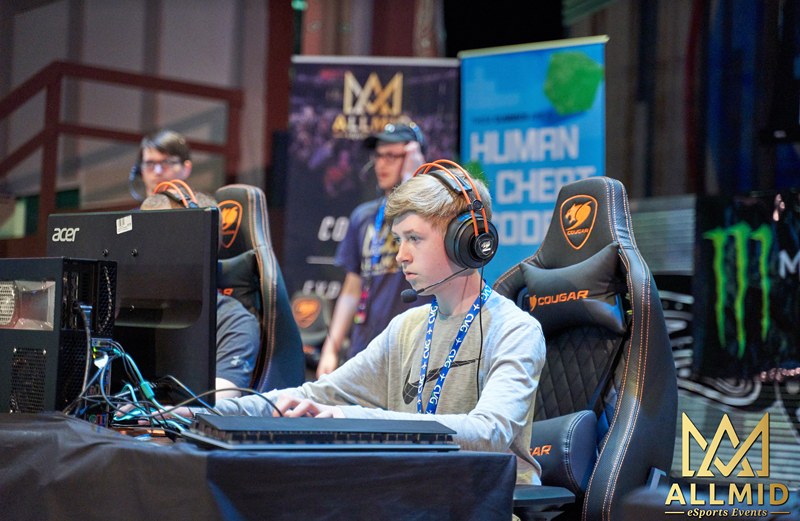While in-person athletic competitions around the country — from collegiate to professional teams — have stalled as a result of the COVID-19 pandemic, the electronic sports (eSports) industry continues to grow its audience across streaming platforms like Twitch and Facebook Gaming.
Data from Stream Hatchet, which compiles game-streaming analytics, shows that from April to June 2020, Twitch reached a platform record of 5 billion hours in total time watched. Compared to the previous quarter, which was also record-breaking, this is a 62.7% increase in hours.
The additional traffic could be attributed to the movement of many gaming conventions to virtual, or the stir-craziness that comes with running out of shows to binge-watch on Netflix. One such convention, MomoCon, which had over 120,000 in turnstile attendance last year, transitioned online with the assistance of a local event organizer.
AllMid, short for All Midwest, is a Cincinnati-based eSports organizer. Started in 2015 by Niko Tsirlis, AllMid hosts collegiate, convention and community eSports events. Last year, the group hosted a video game conference at Kings Island called PiviP, complete with sponsors, keynote speakers and an eSports tournament where players competed for their share of a total of $20,000.
When 2020 started, AllMid had a full calendar, Tsirlis says. In January, the group organized a Super Smash Bros. tournament with Cavs Legion GC, the Cleveland Cavaliers’ official NBA 2K eSports team. Then, in February, AllMid hosted an eSports showcase tournament with students at Procter & Gamble headquarters.
As was the case for most of humanity, future plans were put on hold due to safety concerns as COVID-19 began to spread throughout the United States.
Pivoting, AllMid began hosting events online through Twitch and helped transition conventions like MomoCon to digital platforms.
“eSports has an advantage because we can run those virtual events,” Tsirlis says. “And, I think those communities that have a solid reputation and that have been around for a while can continue to do well, even in a COVID world.”
On the collegiate level, the University of Cincinnati’s eSports Club, an umbrella club for popular eSports games such as Super Smash Bros., League of Legends and Counter-Strike: Global Offensive (or CS:GO) has also had to do some adjusting.
Kevin Edmonds, vice president of UC’s Super Smash Bros. Club and social media manager for UC’s eSports club, said most games adjusted well to online tournaments, but others proved more difficult.
“Most of the games from UC eSports that aren’t Smash did fine, as they were usually already played online in scrims and actual matches,” Edmonds says. “Rarely did they ever meet up in person for actual matches.”
The difficulty in playing fighting games using WiFi connection comes from the necessity of being in sync with the opponent. WiFi is less stable compared to using a wired connection via an ethernet cable, and in games like Super Smash Bros. and Street Fighter, where every fraction of a second counts, a bout of instability from WiFi can cost a game.
Unfortunately for Super Smash Bros. Ultimate players, the game’s netcode — a term that refers to networking in online games — is not the best, says Edmonds. During online tournaments, players are asked to use ethernet cables to ensure a stable connection.
Still, eSports Club president Mika Kumar says that with the exception of fighting games, eSports have been more or less business as usual. Although players now have to play remotely and without fans cheering them on, the pandemic has benefited the gaming and eSports industry, she says, citing higher user engagement and revenue.
Between April and June, video game spending reached a record $11.6 billion, a 30% increase compared to the same period last year, according to market analyst The NPD Group. Physical, digital and subscription sales accounted for $10.2 billion in revenue, while game hardware revenue from consoles such as Playstation 4, Xbox One and Nintendo Switch saw a 57% increase from 2019 to $848 million.
“During the pandemic, many have turned to video games not only to keep them preoccupied, but also to stay in touch with family and friends,” says Mat Piscatella, NPD’s games analyst. “This has resulted in an acceleration of what were already established trends toward heightened video game player engagement. I don’t see any signs of this slowing down.”
Meanwhile, eSports revenue is expected to grow to $1.1 billion in 2020, up from $950.6 million last year, according to data from Newzoo, a video game market analyst. Newzoo also expects the audience for eSports to grow to 495 million globally in 2020, up 11.7% from 2019.
“With other aspects of life being hindered by the pandemic, it's nice to see a huge part of my life stay relatively normal,” Kumar said via direct message. “And, while I'll miss going to in-person events and meeting pro players, I don't mind joining in on the fun from home either.”
While in-person tournaments and events may not be back in force for a while, Tsirlis believes the eSports industry is doing well.
“Ohio and the Midwest in general is doing pretty well with eSports right now,” he said. “There is great university representation. I think overall, Ohio is pretty strong in the eSports community.”






